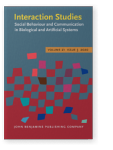Klaus Zuberbühler
List of John Benjamins publications for which Klaus Zuberbühler plays a role.
2020 How apes get into and out of joint actions: Shared intentionality as an interactional achievement Interaction Studies 21:3, pp. 353–386 | Article
Compared to other animals, humans appear to have a special motivation to share experiences and mental states with others (Clark, 2006; Grice, 1975), which enables them to enter a condition of ‘we’ or shared intentionality (Tomasello & Carpenter, 2005). Shared intentionality has been suggested to… read more
2013 Primate communication New Perspectives on the Origins of Language, Lefebvre, Claire, Bernard Comrie and Henri Cohen (eds.), pp. 187–210 | Article
An influential position in linguistics is that human language has not evolved primarily as a communication device, but as a “system of thought.” This system enables humans to refer to the outside world in ways that cannot be reduced to a “peculiar nature belonging to [a] thing” and to construct an… read more
2011 Living links to human language Primate Communication and Human Language: Vocalisation, gestures, imitation and deixis in humans and non-humans, Vilain, Anne, Jean-Luc Schwartz, Christian Abry and Jacques Vauclair (eds.), pp. 13–38 | Article
2009 The primate roots of human language: Primate vocal behaviour and cognition in the wild Becoming Eloquent: Advances in the emergence of language, human cognition, and modern cultures, d'Errico, Francesco and Jean-Marie Hombert (eds.), pp. 235–266 | Article
Our research describes the natural communication in different primates, as well as their underlying cognitive abilities. We are interested in the communication skills and social cognition of monkeys and apes in their natural habitats. For this purpose, we observe wild groups in Africa and Asia… read more



